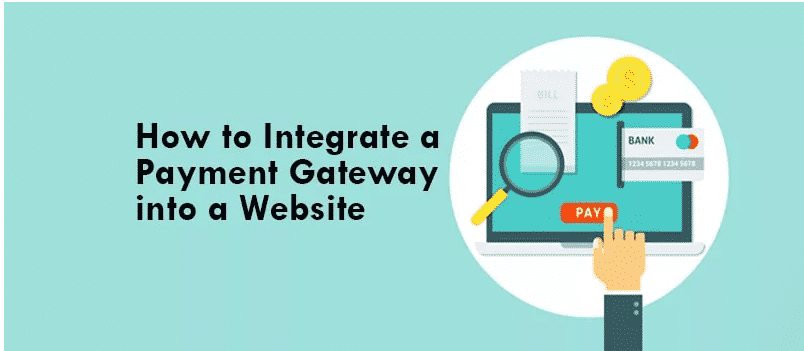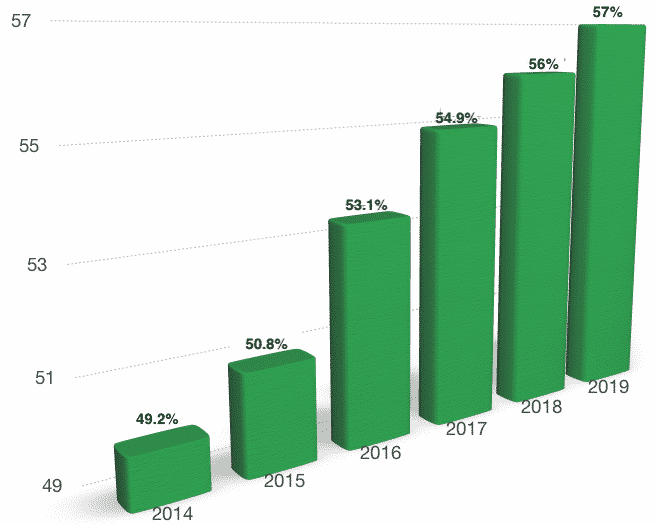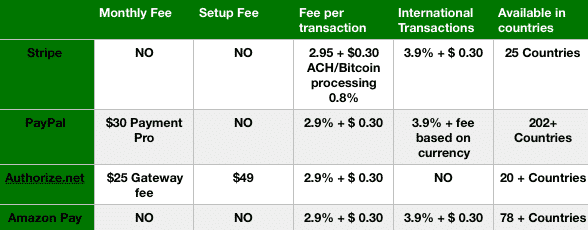Almost every big and small businesses have websites, the main purpose of putting a business in digital wheels is to facilitate customers with flexible options and making business operations more smooth and easy for customers to engage with. Whether you are an E-Commerce Business that sells products online or an online service provider, the website is a need to connect with your customers and to stay ahead in the business.
Simpalm is a top web development company in Maryland, and has integrated several payment gateways in websites for its clients. A website may have many different functionalities according to the business need. But, the payment gateway is required in most of the cases, a trusted and well-functioning payment gateway reflects a faithful business image to its customers.
Graphical representation of growth in the number of online buyers from 2014 to 2019.
Note – Numbers shown in the graph are the percentage of online buyers out of total internet users.
What is a Payment Gateway?
A payment gateway is a service used by the online seller that facilitates online buyers to make payments from the same platform using credit and debit cards, internet banking, and others, with ease and comfort by just filling in the required details. It’s basically a separate page in a website, where users get redirected by clicking “Proceed to Pay” or equivalent button. It’s an online payment service provider service that authorises credit/debit card payments for Online transactions.
A payment gateway is a separate service which you can integrate with your platform. Characteristic of a good payment gateway is that it keeps your card data and other details secured with their preferred security measures.
How it works:
- Cardholder:
Starting from cardholder or customer when a customer fills in the transaction details and presses the “pay” button, the details are sent to the merchant’s web server.
- The payment gateway:
The merchant’s server receives the data and sends it to the payment gateway in the form of API which is called an ephemeral token.
- Payment processor:
The information then goes to the third-party payment processor, payment processors are connected with merchant’s account and the payment gateway, then it transfers the transaction information both sides, payment data is passed through a card network, for example, Visa, Mastercard, Discover etc.
- Card network:
Card network passes the information to the issuer bank. The issuer bank processes the details at their end and sends back the approval or denial status to the payment processor.
- Transaction Status:
The payment processor sends the transaction status to the payment gateway and payment gateway passes the same to the user interface.
- Fund transfer:
If the status is “Approved” The funds are transferred to the merchant’s account from issuing bank in a matter of a day or two.
Choosing a Payment Gateway:
A payment gateway processes the customer’s credit card information, thus it should be chosen carefully. It must be secure, PCI DSS (Payment Card Industry – Data Security Standard) compliant, cost-efficient and reliable, to read the terms and conditions is equally important. There are many payment gateway providers that we can subscribe to, like Stripe, Amazon Pay, Authorize.net, PayPal etc. Here in this blog, we are going to take an example of integrating Stripe payment gateway.
There are majorly two types of payment gateways that you can choose according to your business need. One is external or redirect payment gateway, the other is direct or transparent payment gateway.
- External or Redirect payment gateway:
When the user hits the “Pay” button it gets redirected to another page to proceed with the further payment process.
- Direct or Transparent payment gateway:
When the user presses the “Pay” button it doesn’t take the user away from the website and performs the further payment process within the website.
Understanding the Fees:
Price comparison among some of the major service providers in the market.
Understand Transaction Types:
- Authorize
A kind of transaction performed to check whether the customer has enough fund in the account to pay for a particular purchase, it is done for the payment of large volume or in the case of a service that takes a long time to be rendered.
- Capture
After the authorization, the amount deducted or captured from the customer’s account and transferred to the merchant’s account.
- Settlement
This is a kind of transaction which is performed to settle the differences when the access amount is captured from the customer’s account or less than the actual amount.
- Pay by card
When payment is done using credit/debit card by filling in the card’s details within the payment form.
- Pay by Bank account
When the fund is transferred directly from the bank account using internet banking facility provided by the issuer bank.
Integrating the Payment Gateway (Stripe Example)
- Create an account
You need to create an account with Stripe by filling just a few necessary details. Once you are logged in you will get your dashboard.
- Activating the account
It is important to know that you still have to activate your account to take live payments, you actually have to apply for a live account, in order to do that click on “activate your account” and fill in some more details like, what product you will be selling, your business account details, your personal info, and some bank details. Enter all details and submit it, the account will be activated instantly.
- Stripe’s build guide SDKs and APIs.
You can find the Stripes pre-build library in Stripe’s official website, it will reduce the time consumption in the integration by your web development team, you don’t need PCI compliance in this case.
Stripe gives two options: Either you can use the pre-built components or you can create your own custom forms or UI.
Conclusion:
If you want to gain brand value in the market, creating a custom payment gateway from scratch gives you a good brand image. Integrating the third party payment processor is suitable for startups and small volume businesses, way of integration depends on the type of payment gateway chosen, it requires a sound accuracy and experience for your development team to do it efficiently, in many cases customers leave the payment process in between because of the complex payment checkouts.

 App Development
App Development Web Engineering
Web Engineering AI Services
AI Services Startups
Startups Health / Fitness
Health / Fitness Education
Education Social
Social Nonprofit
Nonprofit Fintech
Fintech Logistics
Logistics Government
Government HR Software
HR Software About Simpalm
About Simpalm Our News
Our News Client Testimonials
Client Testimonials Careers
Careers Awards
Awards Resources
Resources Information
Information




